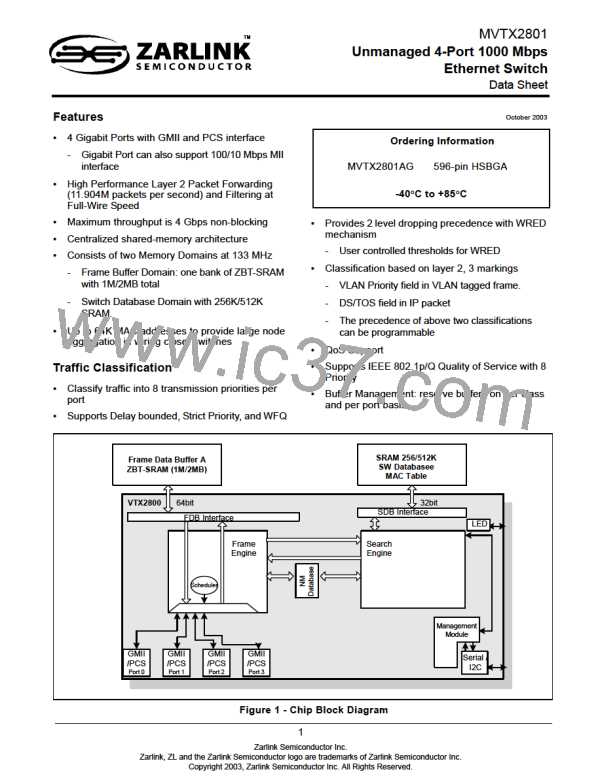MVTX2801
Data Sheet
7.2 Four QoS Configurations
There are four basic pieces to QoS scheduling in the MVTX2801: strict priority (SP), delay bound, weighted fair
queuing (WFQ), and best effort (BE). Using these four pieces, there are four different modes of operation, as shown
in Table 2.
P7
P6
P5
P4
P3
P2
P1
BE
BE
P0
Op1 (default) Delay Bound
Op2
Op3
Op4
SP
Delay Bound
WFQ
SP
WFQ
Table 2 - Four QoS configurations per port
The default configuration is six delay-bounded queues and two best-effort queues. The delay bounds per class are
0.16 ms for P7 and P6, 0.32 ms for P5, 0.64 ms for P4, 1.28 ms for P3, and 2.56 ms for P2. Best effort traffic is only
served when there is no delay-bounded traffic to be served. P1 has strict priority over P0.
We have a second configuration in which there are two strict priority queues, four delay bounded queues, and two
best effort queues. The delay bounds per class are 0.32 ms for P5, 0.64 ms for P4, 1.28 ms for P3, and 2.56 ms for
P2. If the user is to choose this configuration, it is important that P7-P6 (SP) traffic be either policed or implicitly
bounded (e.g. if the incoming SP traffic is very light and predictably patterned). Strict priority traffic, if not
admission-controlled at a prior stage to the MVTX2801, can have an adverse effect on all other classes'
performance. P7 and P6 are both SP classes, and P7 has strict priority over P6.
The third configuration contains two strict priority queues and six queues receiving a bandwidth partition via WFQ.
As in the second configuration, strict priority traffic needs to be carefully controlled.
In the fourth configuration, all queues are served using a WFQ service discipline
7.3 Delay Bound
In the absence of a sophisticated QoS server and signaling protocol, the MVTX2801 may not be assured of the mix
of incoming traffic ahead of time. To cope with this uncertainty, our delay assurance algorithm dynamically adjusts
its scheduling and dropping criteria, guided by the queue occupancies and the due dates of their head-of-line (HOL)
frames. As a result, we assure latency bounds for all admitted frames with high confidence, even in the presence of
system-wide congestion. Our algorithm identifies misbehaving classes and intelligently discards frames at no
detriment to well-behaved classes. Our algorithm also differentiates between high-drop and low-drop traffic with a
weighted random early drop (WRED) approach. Random early dropping prevents congestion by randomly dropping
a percentage of high-drop frames even before the chip's buffers are completely full, while still largely sparing
low-drop frames. This allows high-drop frames to be discarded early, as a sacrifice for future low-drop frames.
Finally, the delay bound algorithm also achieves bandwidth partitioning among classes.
7.4 Strict Priority and Best Effort
When strict priority is part of the scheduling algorithm, if a queue has even one frame to transmit, it goes first. Two
of our four QoS configurations include strict priority queues. The goal is for strict priority classes to be used for IETF
expedited forwarding (EF), where performance guarantees are required. As we have indicated, it is important that
strict priority traffic be either policed or implicitly bounded, so as to keep from harming other traffic classes.
When best effort is part of the scheduling algorithm, a queue only receives bandwidth when none of the other classes
have any traffic to offer. Two of our four QoS configurations include best effort queues. The goal is for best effort
19
Zarlink Semiconductor Inc.

 ZARLINK [ ZARLINK SEMICONDUCTOR INC ]
ZARLINK [ ZARLINK SEMICONDUCTOR INC ]